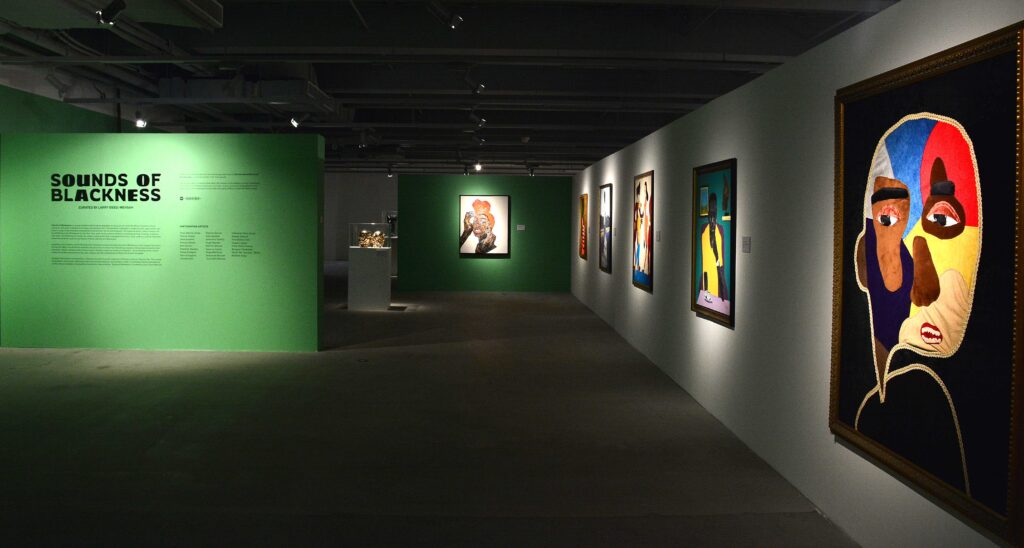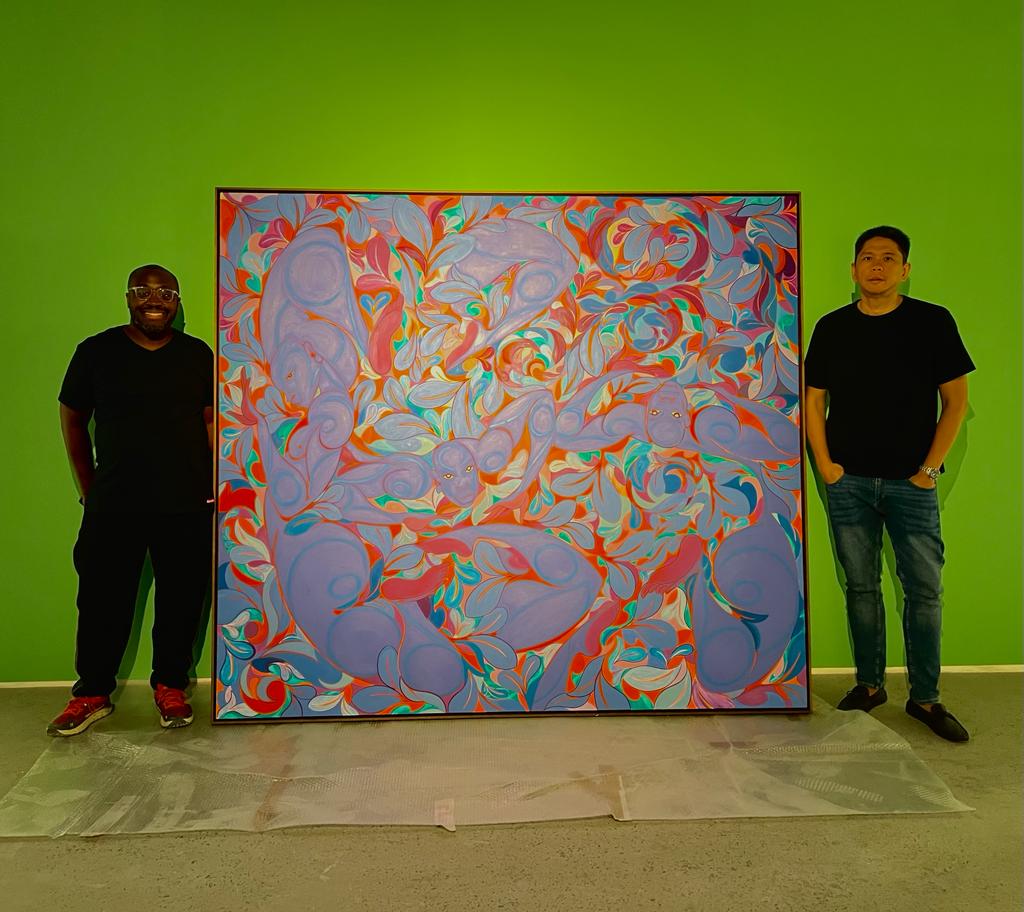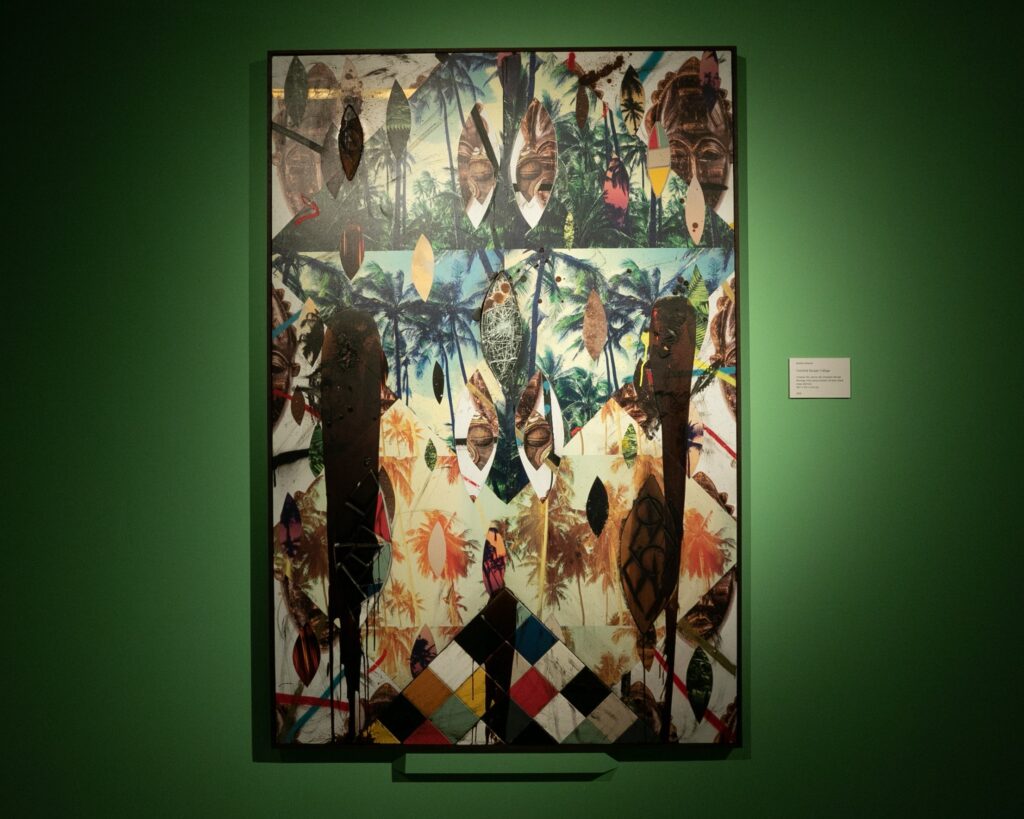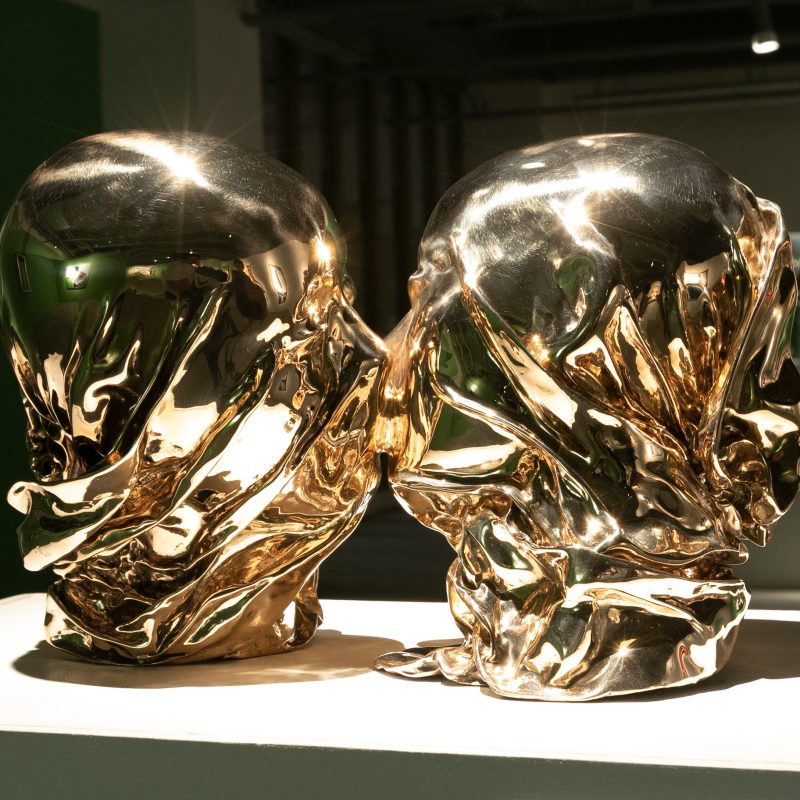A Conversation With Larry Ossei-Mensah and Timothy Tan
Running through 27 June at the Metropolitan Museum of Manila, Sounds of Blackness is a landmark exhibition bringing together the work of artists from the African diaspora, curated by Larry Ossei-Mensah and anchored by works from the collection of Filipino collector Timothy Tan. The exhibition, which takes its title from the name of an award-winning ensemble known for performing a broad range of musical styles, similarly seeks to encompass a diversity of creative expressions and thought, and to celebrate and share Black culture and histories with a wider audience through a sensory experience. Curator Larry Ossei-Mensah and collector Timothy Tan speak with ART SG about their aspirations for this exhibition, and the works that ignited their interest in this genre of art.
Share this article:
Interview by Tan Siuli

Sounds of Blackness, installation view
Hello Larry, congratulations on the opening of Sounds of Blackness! This exhibition marks a significant moment, being the first major presentation of work by Black artists in Southeast Asia. What was the curatorial idea behind it, and what are some of the exhibition highlights, for you?
Larry Ossei-Mensah: For me the curatorial idea around this was about approaching this exhibition as an ensemble of artists who represent the diaspora, and really making an effort to highlight different strategies and approaches, whether it be traditional painting, in the case of Amoako Boafo, or collaging with fabric in the case of David “Mr StarCity” White, or more process-based work in the case of Vaughn Spann — really just trying to show a multitude of approaches and strategies around artmaking.
Many people who’ve come to see the exhibition may have seen the works of these artists online but not in person, so the aim was to give the best examples of these artists’ practice, and also to highlight that artists aren’t just making paintings. So we also included sculpture and video work; the true goal was to show a diversity of approaches, ideas and thoughts, really highlighting the fact that artists from the African diaspora are not a monolith.
I think a lot of attention around these artists has been driven by the market, so I wanted to put together an exhibition that would highlight emerging artists as well as those who have established themselves in their career, and to put these different works in proximity for people to draw their own conclusions. There’s been some fantastic feedback about the conversations we’ve been having around the works, so I’m really excited.
I also spoke to Timothy Tan, the museum and other collectors [whose works are in the show] to get their insights. What was important to Tim was that this be an exhibition that was educational, not just one that shows off ‘all the hits’, so that is why we were super intentional about having a range of artists from emerging to established, so that people can get a true perspective on the breadth and depth of Black creativity today.
The title of the show is named after a R&B gospel group that was popular in the ‘90s, and they have a song called “Optimistic”. That is a general feeling that I get when I look at work by Black artists – it’s optimistic, it’s truthful, it’s honest; it provides a perspective on the world that I’m familiar with but at times it challenges my perspective on the world as well, so that’s why I thought about this exhibition as an ensemble of artists utilizing the name of this legendary ensemble.

Collector Timothy Tan with curator Larry Ossei-Mensah. Image courtesy Timothy Tan.
Why is it important to mount this exhibition in Philippines at this moment in time? Do you see parallels with the art and culture of the exhibition’s host city?
Larry Ossei-Mensah: As much as this is about giving an insight into a diversity of ideas that encompass the Black experience, it’s also a human experience. Creating a scenario where people can see themselves articulated in different ways, for instance in Tschabalala’s piece which is a case of thinking about not only the Black body but also the female body.

Tschabalala Self, Out of Body, 2015
For the audience I think it’s an incredible opportunity to see work by a lot of artists that many people probably encounter through Instagram or auction records, so for me this exhibition was also a way to create a more physical engagement, an ‘IRL’ experience.
Tim and I also wanted this exhibition to be an educational experience, an opportunity for people to learn about the different ways artists express themselves. I hope that it will also be inspiring for Filipino artists to see what these established Black artists are doing, the quality of art they are making, and be inspired in their work and practices. I hope this will be the first of a series of exhibitions that can happen around Asia to create cultural intersectionality. I think at times we can be a little bit divided in our understanding, and art is a great vehicle that can articulate the intersectionality that exists across cultures. I think this exhibition has been a great step towards that effort.
Tim, you first approached Larry last year with the idea of presenting an exhibition of work by Black artists in the Philippines. What ignited your interest in this genre of art, and how did you get started on your collecting journey for Black artists? Why did so much of your collection start to revolve around this genre?
Timothy Tan: I acquired my first piece in Sotheby’s when I came across Vaughn Spann’s rainbow painting. I was drawn to the power of the work and started to look more closely into the art of Black artists. I would visit many galleries and art fairs during my travels abroad, which exposed me to the works of other contemporary Black artists. I really get what Larry is saying about the diversity of Black experiences and the multiplicity of Black voices. I began to see how this was expressed in so many different ways in art that went beyond conventional painting and sculpture, and I was just blown over to discover Rashid Johnson, Mr StarCity, Tschabalala Self etc . who are doing really exciting things in different media. And even when an artist creates what might fall under conventional painting styles, such as Izere Antoine’s “Hello Queen,” the result is strikingly fresh and modern, despite the strong classical and impressionist influences. It is one of my favourite pieces.

Izere Antoine, Hello Queen, 2022
Who are some of the artists, people, or places that inspired you?
Timothy Tan: There’s a lot to mention. But for this genre, I would say Vaughn inspired me a lot. Especially when I started to learn the stories of his works. It still gives me goosebumps every time I tell the people about the story behind the rainbow.

Vaughn Spann, Big Pink (Black Rainbow), 2020
Collectors like Larry Ossei-Mensah, Pamela Joyner and Elliot Perry who keep supporting Black cultures.
For places, I’m very much inspired by the collection of the Rubells, the ICA, and Bass Museum in Miami. It feels like this is my generation and that of most of the artists I’m following.
Coming back to the exhibition, Larry I like how you describe this show as an “ensemble” – a group of voices contributing their individual perspectives to a larger ‘whole’, much like a choir would. This musical parallel is conveyed in the title of the exhibition which shares its name with a Grammy Award-winning ensemble from the US whose oeuvre spans a variety of musical forms, in the same way that you wanted the works in the exhibition to echo the complexities and myriad expressions of Black life across the globe.
Could you say a little bit more about the significance of music in Black culture, and why this is an important metaphor or entry point for the exhibition that you organized?
Larry Ossei-Mensah: In thinking about the show I wanted to approach it as an ensemble of artists, firstly because the African diaspora is so vast, nuanced and layered — it’s not a monolith — and there’s no one particular way of working, or strategy or idea that can encapsulate it, but if you think about it like an ensemble — like a choir or orchestra — everyone contributes their perspective and their talent and artistry to one singular conversation that encapsulates the experience of what it means to be Black.
It’s also important to make a distinction between an African-American experience compared to an artist who is Nigerian-British, or an African artist like Amoako Boafo. So we wanted to make sure we showed a diversity of approaches and ideas as a framework, as inspired by the R&B gospel ensemble “Sounds of Blackness” that was popular in the US in the 1990s.

Amoako Boafo, Red Scarf and Red Nails, 2020
The second part is just thinking about the exportation of Black culture. For most people who don’t live in the US or Europe, their engagement with Black culture is typically through music or cinema, but more so through music. Hip hop culture is an example, and that has been an entry point for people to understand the varying degrees of the Black experience. If you look at how prevalent hip hop has become in the past twenty years, the music has been able to cut through and communicate emotional experiences, and I’m sure most people have grown up with certain hip hop artists in the ‘90s and 2000s. For me, visual art also has this capacity for storytelling and expression, to be evocative. So that was a second layer of thought for this framework for Sounds of Blackness, articulated through visual art.
As part of the show, we have a soundscape curated by Carolyn “CC” Concepcion, which you can listen to on Spotify as you go through the exhibition. The soundscape showcases a multitude of different genres of music coming from the African diaspora, from salsa to merengue, to reggae…all sorts of music that reflects the diversity of ways that people from the African diaspora express themselves through creativity. I think that for me was the core goal of this exhibition, doing that through visual art, through music, and through creating a truly immersive and exciting exhibition experience.
Can you take us through some of the conversations or key ‘moments’ in this exhibition?
Larry Ossei-Mensah: Some general themes that unfold are: process, history, time and memory. In terms of the art of making, you see a lot of strategies around collage, such as the case of Mr StarCity who is weaving fabrics together to create figurative works, compared to Rashid Johnson who’s collaging images with mixed media like wood, black soap and glass…that’s something that revealed itself in a very interesting way. We also have a video by Ufuoma Essi where she collages moving image – you have a video of her moving through a landscape layered on top of archival images that create one complete video piece.

Rashid Johnson, Untitled Escape Collage, 2019
Material use is another theme that’s revealed itself, for instance in Hugo McCloud’s work where he’s making paintings but only using plastic bags, or Vaughn Spann who made rainbows using terry cloth; Spencer Lewis who makes paintings on burlap, or Alteronce Gumby who makes abstract paintings using glass. These are some of the small ‘moments’ that I think bring together the exhibition, if you think about different strategies around collaging, and if you think about Black people – it’s nuanced and layered, and there are a lot of components that encompass identity.

Hank Willis Thomas, Everything we see hides another thing, 2022
Another component is thinking about the notion of visibility, articulated through some of the figurative forms in the exhibition. For instance, the work of Kehinde Wiley, who is thinking about visibility but also historical correction, when you think about the omission of Black figures and Black bodies, not only in history but also art history. This is a big part of the practice that he’s become known for over the last twenty years. And then we have the work of Amoako Boafo whose work is about Black joy and Black subjectivity, and you have that in conversation with someone like Delphine Desane – I think that’s a nice juxtaposition. Life is a juxtaposition – that’s how we learn and how we organize our thoughts, how we recognize parameters and how we recognize that things are in alignment. Juxtaposition is the art of the possible. And that’s why I really make an effort to make this correlation – there is this desire for possibility, and recognition of one’s self in these works, and these works in conversation with each other. The formal juxtaposition, the intergenerational juxtaposition and the juxtaposition of concerns is what makes this exhibition exciting, because for me that’s where I learned. It’s not just about mounting an exhibition – it’s also about an opportunity for learning. These are the seeds of information and insights that then birth other exhibitions and other conversations. So I’m super excited that we have the opportunity to make these micro conversations happen.
To have a group of artists working across different mediums and representing different geographies, but with an affinity or some kind of active tissue that links them, is an important thing to explore. The African diaspora is vast, for a variety of reasons. The ramifications of slavery, of colonialism, for me, was something that was interesting to identify, in putting together this exhibition and thinking about the Philippines and its colonial history – 400 years of Spanish control. Even though obviously there’s some cultural difference, when you have groups of people who have been victims of oppression but have found ways to be resilient, found ways to make something beautiful out of a very ugly situation, there’s always going to be a kinship. And so this exhibition is looking at this kinship: we’ve all gone through these hardships, and through art – whether that be visual arts, cinema, music or fashion – we have found outlets to express ourselves, negotiate this pain and trauma, and to use these spaces of creativity as a catalyst and platform for possibility.
For those who want to delve more deeply into the art and culture of the African diaspora, what are some good places to start?
Timothy Tan: Part of the Oxford History of Art series, “African-American Art” by Sharon F. Patton, is probably the best entry for anyone who is interested in African-American art, in the context of the wider African diaspora art, culture, and society. While many institutions worldwide have incorporated art from the African diaspora in their programme, visiting the International African American Museum in Charleston, South Carolina, can provide an overview of the subject and the movement. This museum was 20 years in the planning, and opened in January 2020.
Larry Ossei-Mensah: For those who want to learn more about the African diaspora, there are so many incredible resources. The one that is most readily available to people is the internet and social media – I discover so many artists through there. Look at art news platforms, like Artnet, ARTnews, Artsy. Contemporary And is a blog that highlights a lot of what is happening in the African art community. Art 21 is also a great resource. If you go on Youtube you’ll see conversations with Mark Bradford for example.
There are a number of books like “World of Art” that focus specifically on black art. You’ve got texts by someone like Alain Locke who is considered to be one of the founding fathers of the Harlem renaissance, and then I think about the exhibition Black Male by Thelma Golden and “A Black Gaze “by Tina Campt…but I think the best way is to follow what museums are doing, and if they’re not doing it then demand that they do it, because the other thing that’s important is to express that this exhibition makes sure that the Southeast Asian community gets access to some of the world’s best artists.
Also, get catalogues by the artists you find interesting. We just published a catalogue for Amoako Boafo’s solo exhibition which will be going on view in Seattle this summer, and then at the Denver Art Museum in October – that’s a great book with 5 incredible essays that give you great insight.
I think there are a multitude of resources and information readily available. It’s all about taking the first step to learn and to discover, and my hope is that this exhibition is a catalyst for people to have that urge and desire to go on a journey with us and learn with us.

Installation view
ABOUT THE AUTHOR: TAN SIULI
Tan Siuli is an independent curator with over a decade of experience encompassing the research, presentation and commissioning of contemporary art from Southeast Asia. Major exhibition projects include two editions of the Singapore Biennale (2013 and 2016), inter-institutional traveling exhibitions, as well as mentoring and commissioning platforms such as the President’s Young Talents exhibition series. She has also lectured on Museum-based learning and Southeast Asian art history at institutes of higher learning in Singapore. Her recent speaking engagements include presentations on Southeast Asian contemporary art at Frieze Academy London and Bloomberg’s Brilliant Ideas series.

Share this article: